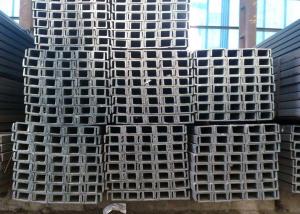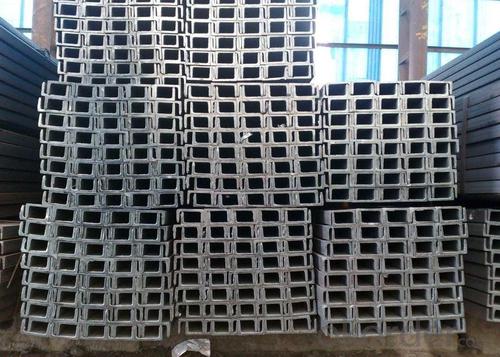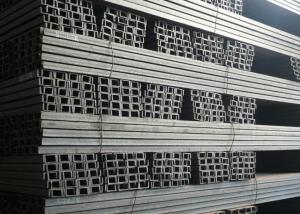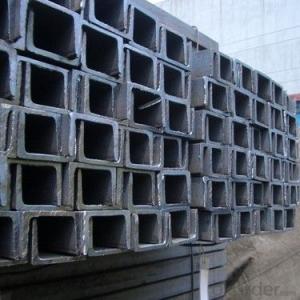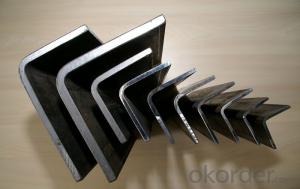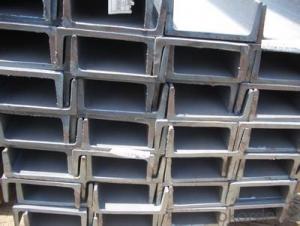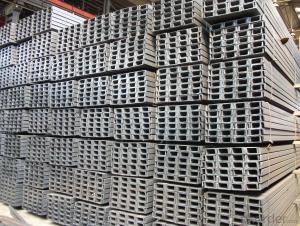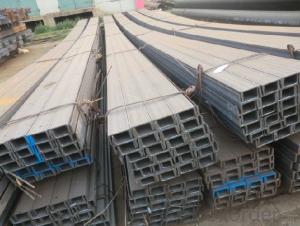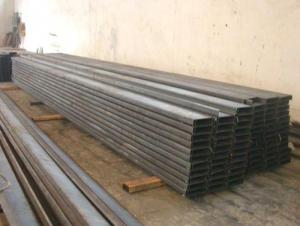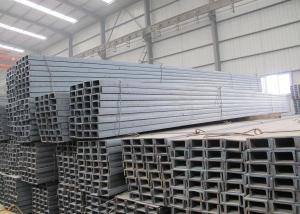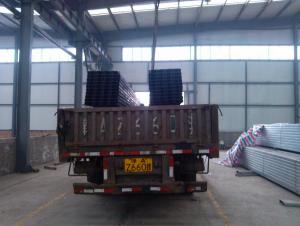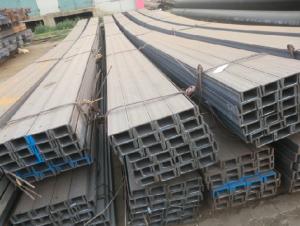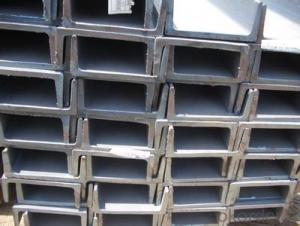Jis Channel
- Loading Port:
- Xingang Port
- Payment Terms:
- TT or LC
- Min Order Qty:
- 25 m.t.
- Supply Capability:
- 80000-100000MTS/YEAR m.t./month
OKorder Service Pledge
OKorder Financial Service
You Might Also Like
Specifications of JIS Channel:
1. We are definitely speciallizing in manufacturing and supplying channel steel as per japanese standard, which is characterised with high mechanical strength and competitive prices.
2. The sections in details are as followings in the table-1
|
JIS CHANNEL |
Standard h |
Sectional b |
Dimension s |
t |
Mass: Kg/m |
|
|
(mm) |
(mm) |
(mm) |
(mm) |
|
|
50x25 |
50 |
25 |
3.0 |
6.00 |
2.37 |
|
75X40 |
75 |
40 |
3.8 |
7.00 |
5.30 |
|
75X40 |
75 |
40 |
4.0 |
7.00 |
5.60 |
|
75X40 |
75 |
40 |
4.5 |
7.00 |
5.85 |
|
75X40 |
75 |
40 |
5.0 |
7.00 |
6.92 |
|
|
|
|
|
|
|
|
100X50 |
100 |
50 |
3.8 |
6.00 |
7.30 |
|
100X50 |
100 |
50 |
4.2 |
6.00 |
8.03 |
|
100X50 |
100 |
50 |
4.5 |
7.50 |
8.97 |
|
100X50 |
100 |
50 |
5.0 |
7.50 |
9.36 |
|
|
|
|
|
|
|
|
125X65 |
125 |
65 |
5.2 |
6.80 |
11.66 |
|
125X65 |
125 |
65 |
5.3 |
6.80 |
12.17 |
|
125X65 |
125 |
65 |
5.5 |
8.00 |
12.91 |
|
125X65 |
125 |
65 |
6.0 |
8.00 |
13.40 |
|
|
|
|
|
|
|
|
150x75 |
150 |
75 |
5.5 |
7.30 |
14.66 |
|
150x75 |
150 |
75 |
5.7 |
10.00 |
16.71 |
|
150x75 |
150 |
75 |
6.0 |
10.00 |
17.90 |
|
150x75 |
150 |
75 |
6.5 |
10.00 |
18.60 |
|
150x75 |
150 |
75 |
6.5 |
10.00 |
24.00 |
|
|
|
|
|
|
|
|
200X80 |
200 |
80 |
7.5 |
11.00 |
24.60 |
Table-1
3. The mechanical property of JIS Channel in the table-2:
|
Grade |
Yield Strength,N/mm² |
Extension Strength N/mm² | |||
|
Thickness of Steel,mm | |||||
|
≦16 |
>16-≦40 |
>40-≦100 |
>100 | ||
|
SS330 |
≧205 |
≧195 |
≧175 |
≧165 |
330-430 |
|
SS400 |
≧245 |
≧235 |
≧215 |
≧205 |
400-510 |
|
SS490 |
≧285 |
≧275 |
≧255 |
≧245 |
490-610 |
|
SS540 |
≧400 |
≧390 |
- |
- |
≧540 |
Table-2
4. The chemical composition of JIS Channel in the table-3
|
Grade |
Element(%) | |||
|
C |
Mn |
P |
S | |
|
SS330 |
-- |
-- |
≦0.050 |
≦0.050 |
|
SS400 | ||||
|
SS490 | ||||
|
SS540 |
≦0.30 |
≦1.60 |
≦0.040 |
≦0.040 |
Table-3
Usage of JIS Channel:
1.The JIS channel can be devided into two kinds, namely common channel steel and light channel steel. The sizes of hot rolled common channel steel range from 5# to 40#. Meanwhile, the channel steel can be divided into cold forming sectional equal channel steel, cold forming sectional unequal channel steel, cold forming inner edge channel steel and outer edge channel steel.
2.The JIS channel is usually used for arch-itechtural structure, and they could be welded in order to support or hang a vari-ety of facilities. They are also usually used in combination with I beam. The channel steel with sizes under 14# is usually applied to construction engineering, as purline, while the channel steel with sizes above 16# is more likely to be used in building vehicle chassis structure and mechanical structure. Furthermore, the channel steel in sizes above 30# are target at building bridge structure, as tension bar.
3.In a word, the channel steel must possess perfect welding property, riveting property and mechanical property and so on.
Package & Delivery of JIS Channel:
1.The JIS channel will be packed in bundle with steel wire at each end of every bundle and color marking in order to help the customer to recognize his goods more easily at sight.
2. And the JIS channel could be loaded into 20ft or 40ft container, or by bulk cargo.If the weight of each bundle reaches more than 3.5 mt, the loading by break bulk cargo should be choosed.When the weight of each bundle reaches less than 3mt, the loading by container should be choosed.
3.As for the transportaion from mill to loading port, the truck will be usually used. And the maximum quantity for each truck is 40mt.
4.All in all, we could do in accordance with customer's request.
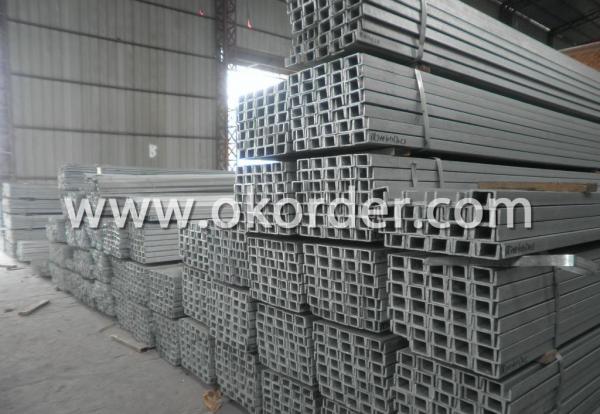
Production Flow of JIS Channel:
1.The steel billet shall be heated in the high temperature furnace.
2. The heated steel billet shall be rolled five to nine times with the aim of shaping the general figure of steel u channel.
3. The rolled steel channel should be put onto the cooling bed to make the temperature low.
4. The JIS Channel should be straighted on the straightener.
5. The straighted steel u channel will be cut into meters by saw, as per customer's requirements.
6. At the last part of production, the channel steel must be tested in order to confirm that the finished products are completely free from crack, pore, slag, scab or fold on the surface.
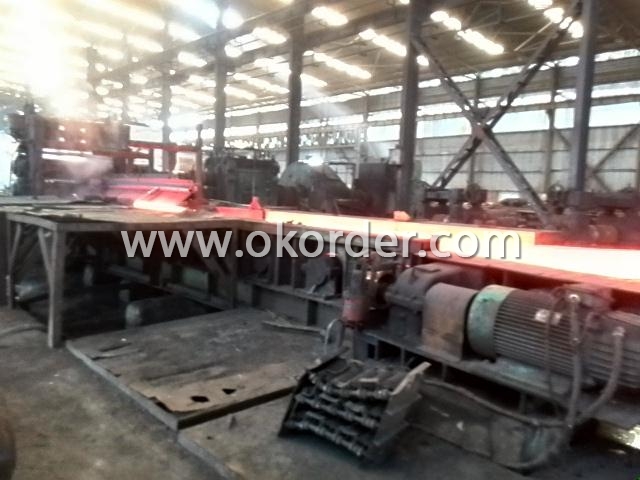
- Q: Can steel channels be used in the agricultural manufacturing industry?
- Yes, steel channels can be used in the agricultural manufacturing industry. Steel channels are versatile and durable, making them suitable for various applications in agriculture, such as constructing farm equipment, machinery, and structures like barns and sheds.
- Q: Can steel channels be used for machinery support?
- Yes, steel channels can be used for machinery support. Steel channels are often used in industrial applications as they provide excellent structural support and can withstand heavy loads. They offer stability and durability, making them suitable for supporting machinery and equipment.
- Q: What are the considerations for selecting steel channel sizes?
- When selecting steel channel sizes, there are several considerations that need to be taken into account. These include the load-bearing capacity required for the intended application, the span or distance between supports, the material and weight of the items being supported, and the structural stability needed. Additionally, factors like cost, availability, and compatibility with other building materials may also influence the selection process. Ultimately, the goal is to choose a steel channel size that can effectively support the intended load while ensuring structural integrity and meeting the project's requirements.
- Q: No. 20 I-beam span 3 meters, fixed on both sides, what is the maximum weight to bear? No. 10 channel steel, span 2.5 meters, the other ibid
- No. 20 I-beam span 3 meters, fixed on both sides, five tons is no problem; 10 channel steel, span 2.5 meters, two tons is no problem.
- Q: Can steel channels be used for elevator shafts?
- Yes, steel channels can be used for elevator shafts. Steel channels, which are structural components made of steel in a "C" shape, are commonly used in construction for various purposes, including elevator shafts. Steel channels provide strength, stability, and support to the elevator shaft structure, ensuring its ability to withstand the weight and load of the elevator car, as well as any additional loads such as people or heavy equipment. Additionally, steel channels can be easily fabricated and customized to fit the specific requirements of the elevator shaft, making them a suitable choice for this application.
- Q: What are the specifications for steel channel coatings?
- The specifications for steel channel coatings typically include factors such as type of coating material, thickness requirements, adhesion properties, corrosion resistance, durability, and any specific industry standards or regulations that need to be met.
- Q: British standard I-beam 203*203*46 size
- The main specifications of the available contour I-beam section size (mm) expressed in high waist leg width (H) * (b) * (d) mm thick waist numbers, such as I160 x 88 x 6, namely said waist height 160mm, waist leg width 88mm, thickness 6mm i-beam. I-steel specifications are available models (Tex) said, showing the type of waist high number of centimeters, such as waist high 160mm I-beam type I 16#. The same as the waist high beam, there are several different leg width and waist thick, need to add code in the model (also known as the right corner) a or B or C to make a difference, such as 32a#, 32b#, 32c# etc..
- Q: What kind of steel products are there, such as channel steel, angle iron and so on?
- Round steelAs the name suggests, round steel is round section of circular solid steel, divided into hot rolling, forging and cold drawn three. Round steel has many materials, such as: 10#, 20#, 45#, Q215-235, 42CrMo, 40CrNiMo, GCr15, 3Cr2W8V, 20CrMnTi, 5CrMnMo, 304, 316, 20Cr, 40Cr, 20CrMo, 35CrMo and so on.Hot rolled round steel specifications 5.5-250 mm, small round steel is 5.5-25 mm, straight bundles of supply, as steel, bolts and various mechanical parts; greater than 25 mm round steel, mainly used in the manufacture of mechanical parts or seamless steel tube blank.
- Q: How do steel channels differ from steel beams?
- Steel channels and steel beams differ in their cross-sectional shape. Steel channels have a U-shaped or C-shaped cross-section, resembling the letter "C" or "U," while steel beams have an I-shaped cross-section, resembling the letter "I." This difference in shape gives each of them distinct properties and applications.
- Q: Are steel channels suitable for use in the construction of balconies or terraces?
- Yes, steel channels are suitable for use in the construction of balconies or terraces. Steel channels provide excellent strength and durability, making them a reliable choice for supporting the weight and load requirements of balconies and terraces. Additionally, steel channels can be customized to fit specific design needs and can withstand various weather conditions, making them a suitable material for outdoor structures.
1. Manufacturer Overview
| Location | Tangshan, China |
| Year Established | 2000 |
| Annual Output Value | Above US$ 50 Million |
| Main Markets | Mid East; Southeast Asia; Korea |
| Company Certifications |
2. Manufacturer Certificates
| a) Certification Name | |
| Range | |
| Reference | |
| Validity Period |
3. Manufacturer Capability
| a) Trade Capacity | |
| Nearest Port | Tianjin |
| Export Percentage | 20% - 30% |
| No.of Employees in Trade Department | 10-20 People |
| Language Spoken: | English; Chinese |
| b) Factory Information | |
| Factory Size: | Above 81,000 square meters |
| No. of Production Lines | 1 |
| Contract Manufacturing | OEM Service Offered |
| Product Price Range | Average |
Send your message to us
Jis Channel
- Loading Port:
- Xingang Port
- Payment Terms:
- TT or LC
- Min Order Qty:
- 25 m.t.
- Supply Capability:
- 80000-100000MTS/YEAR m.t./month
OKorder Service Pledge
OKorder Financial Service
Similar products
Hot products
Hot Searches
Related keywords
